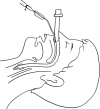Nasotracheal Intubation: An Overview
- PMID: 26224998
- PMCID: PMC4518776
- DOI: 10.1007/s12663-013-0516-5
Nasotracheal Intubation: An Overview
Abstract
Introduction: Nasotracheal intubation is the commonest method used to induce anaesthesia in oral surgery patients. It has a distinct advantage of providing good accessibility for oral surgical procedures.
Anatomy and procedure: One must know the anatomy involved, the pathway and procedure of intubation, the pre-anaesthetic medication and complications which may be seen at the time of intubation. The surgeon must have the knowhow of the tube and the procedure which are explained in detail in the article.
Complications: Several complications can arise while performing the procedure which may be operator induced or arising due to anatomical variations.
Conclusion: It is prudent for the oral surgeon to know the basics of nasotracheal intubation in order to form a useful team member for management of complications arising from anaesthesia. Recent years have seen improvement in the armamentarium. These help negate the blindness of the procedure.
Keywords: Bacteremia; Epistaxis; Fibreoptic endoscopy; Nasotracheal intubation.
Figures
References
-
- Gray’s anatomy (2008) The anatomical basis of clinical practice; nose, nasal cavity and paranasal sinuses, 14th edn. Churchill Livingstone, London, pp 549–551
Publication types
LinkOut - more resources
Full Text Sources
Other Literature Sources
Medical



